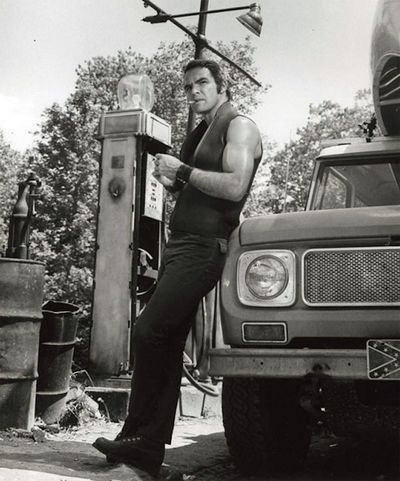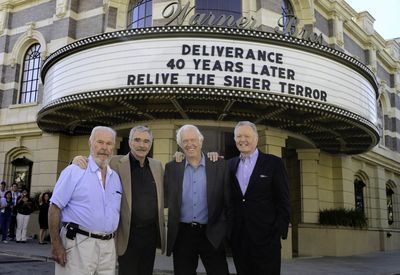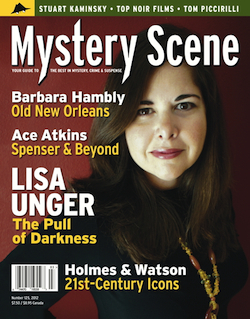Ed Gorman's Blog, page 154
July 11, 2012
Four Men, Forty Years: Deliverance
"Because they're building a dam across the Cahulawassee River. They're gonna flood a whole valley, Bobby, that's why. Dammit, they're drownin' the river...Just about the last wild, untamed, unpolluted, unfucked up river in the South. Don't you understand what I'm saying?...They're gonna stop the river up. There ain't gonna be no more river. There's just gonna be a big, dead lake...You just push a little more power into Atlanta, a little more air-conditioners for your smug little suburb, and you know what's gonna happen? We're gonna rape this whole god-damned landscape. We're gonna rape it." -- Lewis (Burt Reynolds)
Ed here: The truly amazing Kim Morgan not only writes about the film forty years after its initial release she interviews the principal actors.
Burt Reynolds was still full of swagger, quick-witted, smart and charmingly flirtatious. Ned Beatty was jokingly ornery while being genuinely curious about how his wife's golf game was going. Jon Voight was warm and pensive but quick to laugh. Ronny Cox was thoughtful and down to earth. They were all surprisngly easy to talk to, in fact, and all incredibly intelligent. Watching them interact I, at times, felt like I had sat down at a poker game among good buddies -- playfully ribbing and riffing off each other, these men were so comfortable with one another they clearly bonded during that tough shoot all those years back and that bond remains.
Go here for the entire piece: http://sunsetgun.typepad.com/sunsetgu...
July 10, 2012
Changing Hammett Stories
Ed here: Mike Nevins is the Edgar-winning novelist/short-storywriter/biographer/historian whose work with the fiction and life of Cornell Woolrich has been acclaimed as definitive. Here's a small piece of what MIke does so, this a reprint from Mystery-File, one of the truly great sites of all time.
Mike Nevins: I recently attended a convention in suburban Baltimore but arrived before my hotel room was ready. Luckily there was a bookstore with comfortable chairs in the mall across the street, and I killed some time in the mystery section with “Arson Plus,” the first of Dashiell Hammett’s Continental Op stories, originally published in Black Mask for October 1, 1923 and recently reprinted in Otto Penzler’s mammoth Black Lizard Big Book of Black Mask Stories.
For decades this was one of the rarest of Hammett tales, revived only by Fred Dannay (in Ellery Queen’s Mystery Magazine, August 1951, and in the Queen-edited paperback collection Woman in the Dark, 1951).
Today it’s in the Penzler anthology and a major hardcover Hammett collection (Crime Stories and Other Writings, Library of America 2001) and can also be downloaded from the Web in a few seconds.
The other day I felt an urge to compare the e-text with theEQMM and Library of America versions, and made a discovery that startled but didn’t really surprise me. The Web version I downloaded is identical with Fred’s except for a few changes in punctuation and italicization, but both are quite different from the Library of America text, which uses the version originally published in Black Mask. Fred believed that every story ever written was too long and therefore tended to trim the tales he reprinted, even those by masters like Hammett. Some of the bits and pieces he cut were perhaps redundant, but he also axed part of the Continental Op’s explanation at the end of the story.
Reprinting “Arson Plus” in 1951, he must have felt a need to update some of the price references to reflect post-World War II inflation. At the very beginning of the original version, the Op offers a cigar to the Sacramento County sheriff, who estimates that it cost “fifteen cents straight.” The Op corrects him, giving the price as two for a quarter. Fred raised these figures to “three for a buck” and ”two bits each” respectively.
He also added a cool ten thousand dollars to the purchase price of a house that in the 1923 version sold for $4,500. Where a Hammett character disposes of $4,000 in Liberty bonds (sold by the government to finance World War I), Fred has him sell $15,000 worth of common or garden variety bonds.
Whenever Hammett refers to an automobile as a “machine,” Fred changes it to “car.” Where three men in a general store are “talking Hiram Johnson,” Fred has them merely “talking.” (Hiram Johnson, as we learn from a note in the Library of America volume, was governor of California between 1911 and 1917 and later served four terms as senator.)
He also unaccountably changes the name of a major character from Handerson to Henderson. A quick check of Fred’s versions of a few other Continental Op stories with the original texts yielded similar results and a clear conclusion: to read Hammett’s tales as they were meant to be read, you have to read them in the Library of America collection. This doesn’t help, of course, with the eight Op stories not collected in that volume, but it’s a start.
In every version of “Arson Plus” the plot is of course the same: a man insures his life for big bucks, assumes another identity, sets fire to the house he bought, and the woman named as beneficiary demands payment.
Did these people really think any insurance company would be fooled for a minute when there were no human remains in the ashes of the destroyed house? Didn’t Hammett with his experience as a PI realize that this plot was ridiculous? Was Fred ever bothered by its silliness?
***
July 9, 2012
Peter Bogdanovich: Two By Fritz Lang
SHARE ON EMAILSHARE ON FACEBOOKSHARE ON GOOGLE_PLUSONESHARE ON PRINT|MORE SHARING SERVICES0
 Edward G. Robinson Joan Bennet in 'The Woman in the Window' (1944)When Alfred Hitchcock made his first thrillers in the mid-1920s, he was often praised as “an English Fritz Lang,” Lang then being world famous for making nightmarish German crime pictures in the silent era, culminating with such 1930’s sound classics as M (about a child murderer) in Germany, and Fury (about a lynch mob) in the U.S., where he lived and worked from the mid-30s. When asked, Hitch always counted Fritz among his biggest influences, but film history being so fast-moving and fickle, from the mid-1940s onward, Lang was occasionally referred to as “the German Alfred Hitchcock.”
Edward G. Robinson Joan Bennet in 'The Woman in the Window' (1944)When Alfred Hitchcock made his first thrillers in the mid-1920s, he was often praised as “an English Fritz Lang,” Lang then being world famous for making nightmarish German crime pictures in the silent era, culminating with such 1930’s sound classics as M (about a child murderer) in Germany, and Fury (about a lynch mob) in the U.S., where he lived and worked from the mid-30s. When asked, Hitch always counted Fritz among his biggest influences, but film history being so fast-moving and fickle, from the mid-1940s onward, Lang was occasionally referred to as “the German Alfred Hitchcock.”If you’re in the mood for a double-feature of American Lang suspense movies, both excellently representative of the kind of dark, ominous and scary work for which he was known to film buffs internationally, check out Edward G. Robinson, Joan Bennett, and Dan Duryea in 1944’s THE WOMAN IN THE WINDOW (available on DVD) and George Sanders, Vincent Price, Ida Lupino, Rhonda Fleming, Dana Andrews, Thomas Mitchell, and John Barrymore, Jr. (Drew’s dad) in 1956’s WHILE THE CITY SLEEPS (also available on DVD).
Although many actors did not get along with Lang’s autocratic, often dictatorial methods—-Spencer Tracy (afterFury), for example, vowed never to work with him again—- but The Woman in the Window was the first of two pictures Edward G. Robinson did with the director and the second of four that starred Joan Bennett, who reportedly liked him very much.
for the rest go here: http://blogs.indiewire.com/peterbogda...
July 8, 2012
Tales From Super Science Fiction
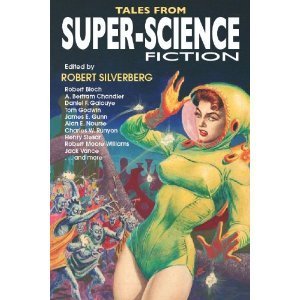
Ed here:
As I've said here before Graham Greene has written that he didn't reread many of the books he revered as a youth because in rereading them he'd spoil his memory of them as perfect. I think most of us has had that experience. You remember a book you read at fifteen as dazzling in both concept and technique only to read maybe thirty pages of it as an adult and find it clunky in every way.
I knew exactly what I find here. More, I knew what I WANTED to find here. And by the Spaceman's Oath I found it exactly. Outlandish and spectacularly colorful science fiction pulp adventure with the emphasis on pulp.
Robert Silverberg not only edited the book and contributed a story but also wrote the author notes, some of which are as interesting as the tales themselves. I didn't find any bad ones and just about all of them came through with flashes of that old sense of wonder. Gimme that sense of wonder, Doc; I gotta have that sense of wonder. I mainline it!
My favorites include Henry Slesar's "Who Am I?" Slesar wrote in every genre there is; he was a plotting master and that skill is clearly on display here. In his author notes about Don Berry Silverberg discusses Berry's too brief sf career; if you doubted that Berry had the stuff read "Song of The Axe" and you'll doubt no more. A few of my other faves here include the Daniel Galouye and the Jack Vance.
To quote an Amazon review:
"By the end of the nearly four year run of Super-Science Fiction magazine, an attempt to transform itself into some sort of monster mag was not working and the magazine folded. Robert Silverberg had three stories in the final issue under three different pen names. The story "The Loathsome Beasts" by Silverberg is from the last issue and is clearly a monsters in space story where sea monsters violently attack a planetary settlement. I liked it in a fun innocent times sort of way. A good finish for this collection of stories."
To complement the stories the complete run of covers are reproduced. Much of the work was done by Emsh (my favorite) and Freas.
What has always struck me about so called "juvenile" action adventure sf is how often it addressed contemporary political problems. Not in any obvious way but subtly and intelligently, Silverberg especially used the sub-genre to address geo-political concerns.
In all an extremely handsome book with interior illustrations from the magazine and stories for anybody who enjoys colorful pulp adventure.[image error]
July 6, 2012
A Face In The Crowd

CULTUREMarch 2007E-MailFILMAn Unforgettable FaceHalf a century after Elia Kazan made A Face in the Crowd, the performances–by Andy Griffith, Patricia Neal, and Anthony Franciosa–are still pungent, the dark tale of media manipulation still resonates, and even fans can't quite define its power.From Vanity Fair.by James Wolcott[image error]
Photograph by George E. Joseph.
Made during the middle slumbers of the Eisenhower era, Elia Kazan's A Face in the Crowd marks its 50th birthday in 2007 and retains its status as one of the most provocative, unplaceable vagrants—or is it mongrels?—of American moviemaking. It's a perennial in-between. It didn't behave then, and it doesn't quite belong now. It has neither indelibly darkened into a lithographic fable, like Charles Laughton's masterwork, The Night of the Hunter, nor faded into parchment. As Richard Schickel observes in his gung-ho biography of Kazan, published in 2005, "The film has never achieved wide popularity, but it has never disappeared, either. It keeps nagging away at us. At some of us, at least." A Face in the Crowdwas and is a satire for the enlightened minority ("some of us, at least") about the threat posed to democracy when TV personalities achieve magnetic sway over the masses and wield their popularity like a whip. If Fascism comes to America, this film suggests, it'll be wearing the friendly, donkey grin of a good ol' boy. Written by Budd Schulberg (who also did the screenplay for Kazan's On the Waterfront), A Face in the Crowd is a dark-hued tall tale about a rough-diamond charismatic—Andy Griffith's singer-joker Lonesome Rhodes—who catapults into national celebrity, only to become the puppet of a populist scheme orchestrated by corporate overlords, who exploit his likability as a lever of social control. Rhodes is no innocent buffoon; he's as cynical as his paymasters. He preys upon the yearnings and insecurities of regular folks and plays them for suckers, until he commits career suicide by open mike, the victim of a "Macaca" moment. A Face in the Crowd might have become an acrid, worrywart exercise in elitist condescension if it hadn't been for the seams-busting acting of Griffith, who unleashes a moody, gutsy force unsuitable for the future sheriff of Mayberry; Patricia Neal, as the film's abused, bruised conscience; Anthony Franciosa, who has the appetite of a gigolo turned jackal; and, gleaming in her screen debut, Lee Remick.
for the rest go here:Day Keene
Day Keene was the pseudonym of Gunard Hjerstedt who was born on the south side of Chicago, the son of a paving contractor, in 1903. Keene became an actor in repertory theatre in the early 1920s. When some of his friends, such as Melvyn Douglas and Barton McClain, decided to try movies, Keene, who had already had some success writing plays for the group, flipped a coin to decide between acting and writing. Writing won.
In the 1930s he began writing scripts for radio soap operas. He was the principal writer for the “Little Orphan Annie” radio program. In 1940 he started contributing to pulp magazines specializing in crime and detective fiction. His first stories were published in Ace G-Man Stories and Dime Mystery and later he graduated to Black Mask and Dime Detective.
Tired of the pressure and the grind, Keene moved to the sparsely populated west coast of Florida, where he became one of the first, best, and most prolific writers to make the transition from the pulps to the newly emerging paperback originals in the late 1940s. He also befriended young writers who had moved there, among them Talmage Powell and John D. MacDonald.
Courtesy of the Maureen Moran Literary Agency
Ed here: Many of you probably own some of the fine collections of Fredric Brown pulp stories published by Dennis McMillan in the 90s. Now I'm told that virtually if not literally all of Day Keene's pulp stories will be collected in similar fashion--running to twelve volumes over the years. I've always liked Keene's stuff. He's never less than readable and sometimes he's almost a genius.
And anybody who roomed with Melvyn Douglas (one of my favorite actors) can't be all bad. What a trio--Keene, Douglas and burly Barton McLain..
July 5, 2012
Forgotten Books: Hard Man by Alan Guthrie
The violence of the story plays well against the violence of the city, which Guthrie manages to make seem much smaller than does Ian Rankin. This is because Guthrie and his multiple cast of characters all inhabit a very small psychological (if not physical) section of the city. If Rankin's cop is looking for something resembling truth, Guthrie's characters are looking for nothing more than satisfying the immediate needs of their rather amusingly diseased minds. Jim Thompson with the heebie-jeebies.
This is a quick, compelling novel that proves that Guthrie is as restless as his characters. I don't think he's a writer who'll settle for doing the same book over and over. This is a calculated and successful departure from his first two books. Interesting to speculate on what he'll do next. Harcourt/Otto Penzler
The New Mystery Scene
In This "At the Scene"
Writers on Reading: Linda Fairstein on Rebecca Inspector Lewis, Series 5 is back in July Overheard: Ace Atkins in The Lost Ones Giveaway: Win a signed copy of No Rest for the Dead byMalla Nunn Organizing Crime Classics guide, a free gift fromMystery Scene with any full-price, 3-year subscription
July Greetings
 St. Louis Cemetery No. 1, New Orleans
St. Louis Cemetery No. 1, New Orleans "The past is never dead. It's not even past."
Requiem for a Nun, William Faulkner, 1951
No place in the world better illustrates this sentiment than New Orleans. And no writer better captures the complexities of this singular city than Barbara Hambly. In our Summer Issue #125, on its way to you now, Jon L. Breen offers an overview of Hambly's meticulously researched, marvelously alive Benjamin January mysteries. Although these novels are set in the 1830s, they cast a revelatory light on the New Orleans of today.
 Lisa UngerWhen Lisa Unger was 15 years old and living in semi-rural New Jersey, a local teenage girl was abducted and murdered. As she reveals in Oline Cogdill's profile, that long-ago tragedy is still playing out in her work today.
Lisa UngerWhen Lisa Unger was 15 years old and living in semi-rural New Jersey, a local teenage girl was abducted and murdered. As she reveals in Oline Cogdill's profile, that long-ago tragedy is still playing out in her work today.Ace Atkins picks up a strand of literary history withLullaby, his continuation of Robert B. Parker's Spenser mysteries. Kevin Burton Smith profiles Atkins in this issue-and gives the revived Spenser a big thumbs up.
In another article, Kevin surveys the many wonderful, long out-of-print crime novels that are suddenly available again in ebook editions. Now that's progress!
Hank Wagner profiles Tom Piccirilli whose new novel, The Last Kind Words, has at its center the twisted history of a family of criminals. (Book review also available at MysterySceneMag.com.)
Michael Mallory discusses how stars from Hollywood's 1940s heyday still shine brightly in Stuart Kaminsky's delightful Toby Peters mysteries.
Sherlock Holmes, of course, transcends time as Bill Hirschman notes in his article about the BBC's fun new TV series.
No matter where you fall on the time continuum, we think you'll find something to enjoy in this issue. Happy reading!
Best wishes,
Kate StineEditor-in-chief
Need Help With Your Subscription?Send us a note. Renew or subscribe at MysterySceneMag.com
July 4, 2012
All The Way Chas. Williams & film version The 3rd Voice

Ed here: Here's an oldie & goodie from the great Mystery*File.com Happy 4th everybody!
Reviewed by Dan Stumpf: CHARLES WILLIAMS All the Way [Book and Film, 1960]Posted by Steve under Crime Films , Reviews
[21] Comments REVIEWED BY DAN STUMPF:

● CHARLES WILLIAMS – All the Way. Dell First Edition A165, paperback original, 1958. UK title: The Concrete Flamingo. Cassell, hardcover, 1960.
● THE 3RD VOICE. Columbia, 1960. Edmond O’Brien, Julie London, Laraine Day. Based on the novel All the Way, by Charles Williams. Director: Hubert Cornfield.
This speculation began in a roundabout way while watchingDeadlier Than the Male (reviewed here ); I noticed that one of the credited screenwriters was listed as “Liz Charles-Williams.”
Hmmm. Seems to me the oughta-be legendary writer Charles Williams was doing things at Universal about that time: The Wrong Venus was being filmed as Don’t Just Stand There!, and wasn’t The Pink Jungle some of his work? So could “Liz Charles-Williams” have some connection with the author of Dead Calm and The Big Bite?
Well, after several minutes of painstaking research, I still couldn’t say, but I was prompted to pull out my video of The Third Voice and my copy of the Charles Williams book it was based on, All the Way, and revisit both.
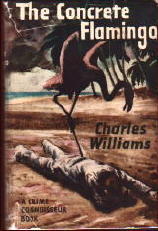
Williams’ novel is a compact, neatly built thing based around an intriguing premise: in order to commit the perfect crime, Jerry Forbes has to spend a week impersonating a man he doesn’t resemble… whom he helped murder.
The hook is that the victim is a neurotic Midwestern businessman on vacation in Florida, and Forbes’ voice sounds exactly like his, so the plot — hatched by the dead man’s jilted mistress — is to kill the businessman, then drain his accounts by phone calls to his underlings back home, all this with her help.
It takes talent to hold a complicated thing like this together in a novel, much less put it across in 160 pages, but Williams was at the top of his form here, with well-wrought characters and nicely judged situations that build suspense beautifully.
Hence All the Way emerges as a deft little book that deserves to be better known. I particularly liked the little character quirks that lead up to an emotional double-cross that you won’t see coming, even now that I’ve told you it’s on its way.
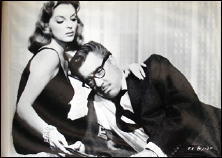
In 1960 Columbia filmed this as The Third Voice which may make it the first paperback original made into a movie; I don’t know. At any rate, while not quite up to the level of the book,Voice is a nice, sick little item which falls well short of Classic Status but still repays watching.
Voice was written and directed by Hubert Cornfield, who put some interesting things on film (Plunder Road, Pressure Point) before the experience of trying to direct Brando in Night of the Following Day crippled his talent.
Or maybe there wasn’t much talent to begin with: Cornfield’s films all look like the work of a promising new talent, but somehow he just never followed through. At any rate, The Third Voice is still nasty and promising.
It’s set in a swanky Mexican resort, but there are no sun-drenched views of lovely beaches; just lots of sweaty close-ups of Edmond O’Brien moving through rooms of cloying chintziness as he bullies strangers over the phone and plots his own little turnabout, leading to a typical noir ending. The effect is claustrophobic, but tellingly so, and I like this movie perhaps more than it deserves.
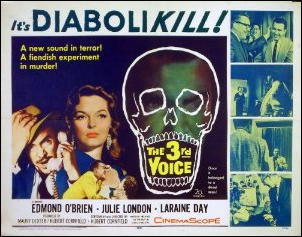
Mon 28 Nov 2011
July 3, 2012
He Had the Good Sense Not to Fight the Role That Defined Him for Generations
 Post a CommentPrint This Page30 inShareBy Steve Pond
Post a CommentPrint This Page30 inShareBy Steve Pond"I fit in a real peculiar slot," wrote Andy Griffith in 1959. At the time, he might have been right: He was a North Carolina-bred actor and occasional musician and comic who'd studied to be a preacher and made his film debut in "A Face in the Crowd," a tough Elia Kazan satire about a scheming country boy who becomes a TV star.
But before long, Griffith's slot didn't seem peculiar at all. The following year, "The Andy Griffith Show" debuted on CBS, and the next eight years presented an Andy Griffith that would come to be an indelible part of the television and pop culture of the era: slow-talkin', easygoin', good-hearted, folksy Andy.
Also read: Andy Griffith Dead at 86
Griffith had the sense not to fight the role that defined him for generations; he occasionally ventured into darker waters in his work, but he knew that he would forever be Sheriff Andy from Mayberry.

And to all appearances he was fine with that from the time the show debuted until Griffith's death this week at the age of 86.
The accolades, for the most part, went elsewhere: Co-star Don Knotts won most of the Emmys for "The Andy Griffith Show" (the series' namesake was never even nominated), while Griffith's onscreen son Ron Howard went on to become a Hollywood heavyweight.
for the rest go here:
http://www.thewrap.com/tv/article/and...
[image error]Ed Gorman's Blog
- Ed Gorman's profile
- 118 followers


